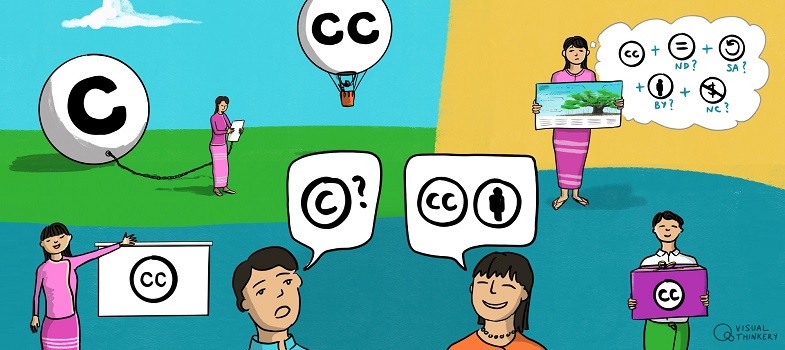CC licence basics
All Creative Commons licences have many important features in common:
- Every CC licence ensures licensors get credit for their work.
- CC licences work around the world.
- A CC licence lasts as long as applicable copyright lasts (because they are built on copyright) and as long as the user complies with the licence. Under the new Myanmar Copyright Act, most works are protected by copyright for 50 years after the creator’s death.
- At a minimum, every licence helps creators (called ‘licensors’ when they use CC tools) retain copyright while allowing others to copy and distribute their work in unadapted form for non-commercial purposes. The common features of each licence serve as the baseline, on top of which licensors can choose to grant additional permissions when deciding how they want their work to be used.
As you may have noticed in the earlier example, CC licences include a version number. At August 2020, the current version of the CC licences is 4.0. Throughout this course, please assume all descriptions of licences refer to this version of the CC licence suite, unless otherwise noted. (You will learn more about the different versions in Section 3.4.)
Choices for the licensor
All Creative Commons licences are structured to give the user permission to make a wide range of uses as long as the user complies with the conditions in the licence. The basic condition in all the licences is that the user provides credit to the licensor and certain other information, such as where the original work may be found.
A CC licensor makes a few simple decisions on the path to choosing a licence: ‘First, do I want to allow commercial use, and second, do I want to allow derivative works (also known as adaptations)?’ We’ll address how to do that in a later section.
If a licensor decides to allow derivative works, they may also choose to require that anyone who uses the work (called licensees)make their new work available under the same licence terms. This is what is meant by ‘ShareAlike’ and it is one of the mechanisms that helps the digital commons of CC-licensed content grow over time. ShareAlike is inspired by the GNU General Public Licence [Tip: hold Ctrl and click a link to open it in a new tab. (Hide tip)] , used by many free and open source software projects.
These different licence elements are symbolised by visual icons:
 | This symbol means Attribution,or ‘BY’. All of the licences include this condition. This is because you must attribute when you use any CC-licensed resource. Best practice for attribution means providing the title, author, source and licence. We will see some examples of how to attribute resources you use throughout the rest of the course. |
 | This symbol means NonCommercial,or ‘NC’, which means the work is only available to be used for noncommercial purposes. This means you cannot profit or make money from the resource. Three of the CC licences include this restriction. |
 | This symbol means ShareAlike,or ‘SA’, which means that adaptations based on this work must be licensed under the same licence. Two of the CC licences include this condition. |
 | This symbol means NoDerivatives,or ‘ND’, which means reusers cannot make changes to the resource and share adaptations of the work. Two of the CC licences include this restriction. |
When combined, these icons represent the six CC licence options. The icons are also embedded in the ‘licence icons’, which each represent a particular CC licence type. Section 3.3 explores the combinations in detail.
Public domain tools
In addition to the CC licence suite, CC also has two public domain tools represented by the icons below. We met these tools briefly in Section 2.1. These public domain tools are not licences.
 | CC0 enables creators to dedicate their works to the worldwide public domain to the greatest extent possible. Note that some jurisdictions do not allow creators to dedicate their works to the public domain, so CC0 has other legal mechanisms included to help deal with this situation where it applies. (More on this in Section 3.3.) |
 | The public domain mark is a label used to mark works known to be free of all copyright restrictions. Unlike CC0, the public domain mark is not a legal tool and has no legal effect when applied to a work. It serves only as a label to inform the public about the public domain status of a work and is often used by museums and archives working with very old works. |
Licence structure
